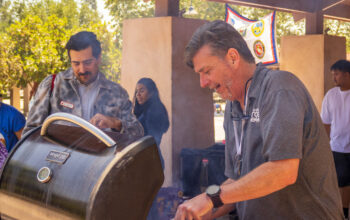As blurred green, turquoise and blue light spread through and lit the planetarium room, the colors of the Aurora, also known as polar lights, made an appearance for a night of education and exploration.
The Pierce College Astronomy Club took its guests on a two-hour tour through the galaxy on Friday, April 13, at the Center for Sciences, during their final Planetarium Show of the semester.
The show was led by Dale Fields, professor of astronomy, who is also the head of the Astronomy Club walked his guests through the Southern Hemisphere to see other constellations and stars that are not visible to us in the Northern Hemisphere starting in Antarctica, and working his way up to Argentina, Brazil and the Equator.
Fields also demonstrated how the sky looks from Los Angeles’ our position on Earth. He emphasized that certain stars can be harder to locate because of the pollution in the air.
Fields said that an advantage of living in Los Angeles is that sunsets last longer than in other areas, such as those near the Equator. He said the period of twilight during sunset lasts longer, so people get to enjoy it a little longer than in other parts of the world.
Fields showed the audience what the sky looks like in areas with less light pollution. He said people living in country areas have the advantage of seeing a clearer sky.
Fields also talked about the Constellations and how to find them in the sky and explained some of their significance. He said the 12 main constellations reflect the signs of the zodiac.
Fields said that although there are actually 13 zodiacs, the Greeks omitted the 13th sign, Ophiucus, because 13 was considered an unlucky number. The sun’s light passes through Ophiucus from Nov. 30 to Dec. 17, which means those born during in that span of time are born under the Ophiucus sign and are not Scorpios.
The show had approximately 20 people in attendance. Fields said the low turnout wasn’t an issue for him.
“We want enough people so that there’s enough questions to go along, but you also don’t want so many people that some people don’t get a chance to talk and know what’s happening. This is actually just the number of people I was looking for,” Fields said
Anamarie Alcazar, an art major, said she wished Fields had more than two shows per semester.
“I like Mr. Field’ s Enthusiasm. Honestly, it’s what I came here for,” Alcazar said.
Leetal Cohen, an astronomy tutor, said events like these inform people on all that astronomy has to offer.
“It’s a great experience and all-inspiring. You’re inside, it’s completely dark and the seats are comfortable. Not a lot of people are that educated on astronomy. If you are not taking an astronomy class its really cool to know what is around us and where things are in the universe. Astronomy can be overlooked. It is all about perspective,” Cohen said.
The Astronomy Club’s next event is a Telescope Night, which is scheduled for May 21 from sunset to 10:30 p.m. in the Center for Sciences.




